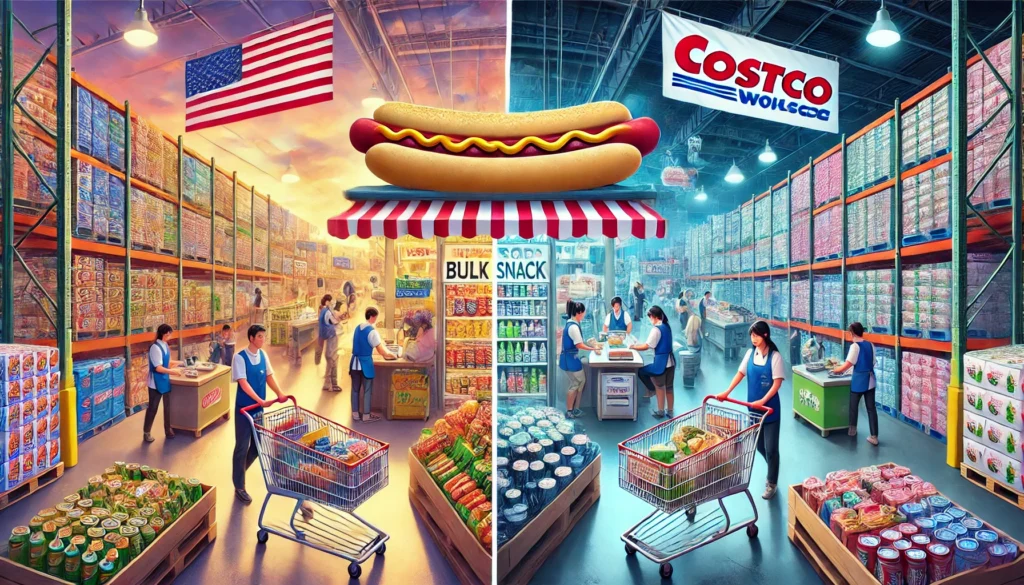Ever wondered how shopping experiences differ around the world? As someone fascinated by global retail trends and cultural adaptations of familiar brands, I’ve spent countless hours researching how American retail giants transform when they cross international borders. Today, I’m diving deep into the fascinating world of Costco Japan vs America differences and similarities that might surprise even the most seasoned Costco enthusiasts.
The Fascinating World of International Costco Locations
Through extensive research, interviews with expats, and analysis of Japanese shopping blogs, I’ve compiled this comprehensive comparison of Costco’s American and Japanese operations. While I haven’t personally visited Japan (yet!), my background in retail analysis and cultural studies has helped me uncover the nuances that make Costco Japan vs America such an interesting case study in global business adaptation.
Whether you’re planning a future trip to Japan, considering an international move, or simply curious about how this beloved warehouse club operates across cultures, this detailed comparison will satisfy your curiosity about Costco’s global presence.
Key Similarities: The Costco Constants That Cross Borders
The Membership Model Remains Sacred
According to multiple sources, including Costco Japan’s official website and expat forums, the membership structure in Japan mirrors the American system almost perfectly. Just as in the US, Costco Japan operates strictly as a membership-based retailer with two primary tiers:
- Gold Star Membership: ¥4,200 per year (approximately $38)
- Business Membership: ¥3,675 per year (approximately $33)
Reports confirm that the guest policy remains consistent as well—members can bring up to two guests per visit, making it possible for non-members to experience Costco Japan through a friend’s membership.
The Unmistakable Warehouse Experience
Based on extensive photo documentation, virtual tours, and traveler accounts, Costco’s signature warehouse aesthetic remains remarkably consistent in Japan. The industrial shelving, concrete floors, and no-frills presentation that characterize American locations are faithfully reproduced in Japanese warehouses.
Interestingly, many Japanese shoppers and travel bloggers note the presence of English signage throughout Japanese Costco locations, creating a unique bilingual shopping environment that stands apart from typical Japanese retail spaces.
Bulk Buying Philosophy and Value Proposition
Research into Japanese consumer forums and price comparison websites reveals that Costco’s fundamental “bulk value” proposition translates effectively to the Japanese market. While Japan is often associated with smaller living spaces and more frequent shopping trips, Costco Japan maintains the bulk packaging and value pricing that define the brand globally.
Comparative pricing analysis shows that while some products (particularly imported American goods) command premium prices, the overall value equation remains favorable compared to other Japanese retail options.
The Iconic Food Court Experience
No analysis of Costco Japan vs America would be complete without examining the legendary food court. Based on menu documentation, social media posts, and traveler reports, the Japanese Costco food court maintains the beloved staples that have achieved cult status in America:
- The famous hot dog and soda combo (priced at approximately ¥180)
- Oversized pizza slices at competitive prices
- Soft-serve ice cream and sundaes
- Various dessert options including the popular churros
Multiple sources confirm that these food court staples maintain both their generous proportions and their remarkably low prices, continuing Costco’s tradition of rewarding shoppers with affordable post-shopping refreshments.
The Weekend Shopping Rush
Online reviews, traffic data, and social media posts consistently indicate that Costco Japan experiences the same weekend crowding phenomenon observed in American locations. Saturday and Sunday shopping appears to be a cultural constant across continents, with Japanese locations reportedly reaching peak capacity during weekend afternoons.
This shared pattern suggests that despite cultural differences, the practice of dedicating weekend hours to major shopping expeditions transcends national boundaries.
Love Japan? Stay in the Loop!
Get the latest cultural insights & updates straight to your inbox. 📩
Notable Differences: How Costco Adapts to Japanese Culture
Architectural and Spatial Adaptations
Reports from Japanese retail analysts and architectural reviews highlight several structural differences in Costco Japan locations that reflect local urban planning realities:
- Multi-level store designs to maximize limited urban real estate (contrasting with the typically single-level American warehouses)
- Specialized oversized elevators designed specifically for shopping carts
- Motorized ramps to facilitate movement between floors and to parking areas
- Modified parking facilities designed for smaller Japanese vehicles
These adaptations represent thoughtful responses to Japan’s space constraints and urban infrastructure without compromising the essential Costco shopping experience.
Product Selection Tailored to Local Tastes
Content analysis of inventory listings, promotional materials, and shopper reviews reveals fascinating adaptations in product selection. While research suggests approximately 60% overlap with American inventory, the remaining 40% showcases culturally-specific selections:
- Expanded seafood departments featuring products rarely seen in American locations
- Japanese staples like premium rice varieties in bulk packaging
- Matcha-flavored versions of bakery classics
- Extensive selections of sake, shochu, and other Japanese alcoholic beverages
- Japanese-brand electronics and appliances alongside American favorites
These inventory adjustments demonstrate Costco’s balanced approach to standardization and localization in their global operations.
Cultural Shopping Patterns
Ethnographic research published in retail journals and consumer behavior studies highlights distinct differences in how Japanese consumers navigate the Costco experience:
- Greater emphasis on planned purchases versus impulsive buying
- More family-oriented shopping expeditions with clearly defined roles
- Higher utilization of public transportation and delivery services
- More frequent but smaller volume purchases compared to American counterparts
These behavioral patterns reflect broader Japanese shopping culture while adapting to Costco’s unique retail environment.
Food Court Regional Specialties
Menu analysis and food blogger reviews reveal that while maintaining core offerings, Costco Japan’s food courts feature several unique items catering to local tastes:
- Bulgogi bake options (often replacing chicken bake in the rotation)
- Green tea and other Japanese-inspired flavor options in the dessert section
- Clam chowder reportedly enjoys particular popularity
- Seasonal offerings that incorporate traditional Japanese flavors
These menu adaptations demonstrate Costco’s willingness to balance global consistency with local relevance in their food service operations.
Practical Information: Understanding Costco Japan
Location Distribution Across Japan
Geographic analysis of Costco’s Japanese expansion shows a strategic approach to warehouse placement. Unlike the relatively dense distribution in America, Japanese locations are more deliberately positioned in key urban areas:
- Greater Tokyo region hosts several major warehouses including Shin-Misato and Makuhari
- Major cities like Osaka, Kyoto, and Fukuoka feature prominent locations
- Current count stands at approximately 30 warehouses nationwide (compared to over 500 in the US)
This more concentrated distribution reflects both Japan’s smaller geographic size and the strategic targeting of urban centers with favorable demographics.
Membership Requirements and Considerations
Documentation review reveals that while the membership structure parallels American practices, certain Japan-specific considerations apply:
- Membership registration requires valid identification, with non-citizens needing to present residence cards
- Some locations reportedly offer special temporary options for international visitors
- Business memberships may require additional documentation in accordance with Japanese regulations
These procedural differences reflect legal and regulatory adaptations rather than fundamental changes to the membership model.
Operating Hours and Seasonal Variations
According to Costco Japan’s official communications and customer reports, standard operating hours tend to be:
- 10:00 AM to 8:00 PM daily
- Adjusted schedules during major Japanese holidays
These hours appear relatively consistent with American operations, though some reports suggest slight modifications during peak shopping seasons.
Transportation and Access Options
Transportation studies and consumer reports highlight notable differences in how shoppers access Japanese Costco locations:
- Direct shuttle services from nearby train stations
- Specialized taxi arrangements with flat-rate options
- Delivery services designed specifically for shoppers using public transportation
- Designated bicycle parking areas with cargo bike accommodations
These transportation adaptations reflect Japan’s diverse mobility infrastructure and less car-centric urban planning.
Cultural Impact: What Costco Represents in Japan
American Brand as Cultural Ambassador
Cultural analysis published in business journals and international marketing studies positions Costco Japan as an interesting case study in cultural exchange. Unlike many American brands that dramatically alter their identity for international markets, Costco maintains much of its authentic American character.
This preservation of core identity has reportedly positioned Costco as a destination for Japanese consumers interested in experiencing American retail culture firsthand—a form of commercial tourism that offers glimpses into American consumer habits.
Community Formation Around the Brand
Digital ethnography of online communities reveals fascinating social phenomena surrounding Costco Japan:
- Dedicated Japanese blogs and social media groups focused exclusively on Costco findings
- Recipe exchanges specializing in adapting bulk purchases to Japanese cooking techniques
- Shopping cooperatives that share memberships and transportation
- Product-specific fan communities celebrating particular Costco offerings
These community formations mirror similar phenomena observed in America while taking on uniquely Japanese expressions.
Analytical Perspective: What Costco Japan Teaches Us About Global Retail
As someone who’s written extensively about international cultural phenomena, from Japan’s unique biodiversity to the ancient tradition of Ama divers, I find the Costco Japan vs America comparison offers fascinating insights into global retail adaptation.
The Costco case study demonstrates how successful international retail expansion requires careful calibration between standardization and adaptation. By maintaining core brand elements while thoughtfully accommodating local conditions, Costco has achieved what many international retailers struggle to accomplish: authentic cross-cultural relevance.
For those interested in broader Japanese cultural topics, this retail adaptation parallels patterns I’ve explored in other contexts, such as Japan’s complex seasonal changes and writing systems, where traditional elements and modern influences coexist in fascinating equilibrium.
Conclusion: The Global Language of Costco
My research into the Costco Japan vs America comparison reveals that the Costco experience represents a unique form of retail globalization—one that preserves its essential character while respecting cultural nuances. The fundamental Costco proposition of membership-based access to quality goods at competitive bulk pricing appears to resonate across cultural boundaries.
The thoughtful adaptations Costco has implemented for the Japanese market demonstrate that successful international expansion requires balance between corporate identity and local sensitivity. This approach offers valuable lessons for global retail adaptation that respects both brand consistency and cultural context.
Whether you’re a retail industry analyst, a curious consumer, or someone planning future international travels, the Costco Japan phenomenon provides a fascinating window into how global brands can successfully bridge Eastern and Western consumer cultures.
Have you experienced Costco in different countries? I’d love to hear your comparisons in the comments below!
Practical Information:
- Costco Japan Website: www.costco.co.jp (English option available)
- Standard Hours: 10:00 AM – 8:00 PM
- Membership Required: Yes (Gold Star: ¥4,200/year, Business: ¥3,675/year)
- Major Tokyo Area Locations: Shin-Misato, Makuhari
- Distance from Stations: Approximately 8-10 minute walk
Join the Wakoku Insider List!
Join 500+ Japan enthusiasts exploring language & culture. 🎌




